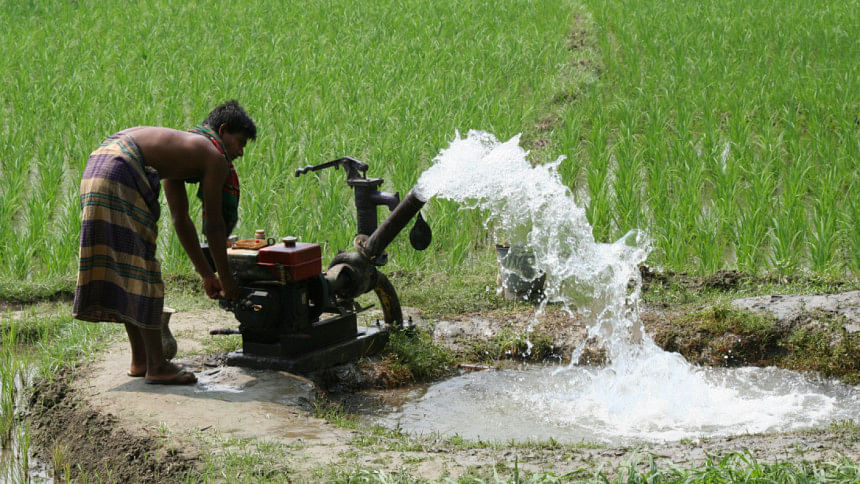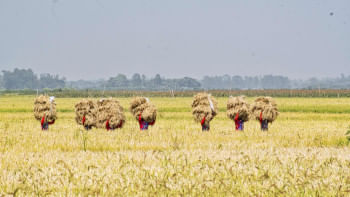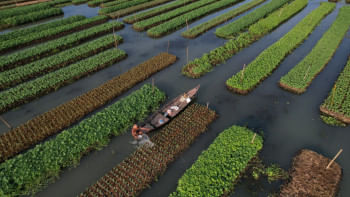How precision agriculture can transform Bangladesh

Agriculture plays a pivotal role in Bangladesh's economy, employing approximately 35.27 percent of the workforce and contributing about 11.55 percent to the national GDP. Traditional farming methods, however, are becoming less sustainable due to their excessive reliance on synthetic fertilisers and excessive water use. Currently, Bangladesh imports 80 percent of the 6.9 million tons of fertiliser consumed annually. Furthermore, about 90% of the country's groundwater is used for agriculture. As a result, many parts of the country, especially the northwest and southwest such as Rajshahi, Naogoan, Natore, Dinajpur, and Jashore districts, often suffer from water scarcity.
Precision agriculture (PA) offers a promising solution to this acute problem. PA uses advanced technologies to enhance crop production while minimising waste and environmental impact. Tools like sensors, satellites, drones, and GPS-enabled machinery help farmers monitor their fields more efficiently. Soil sensors measure moisture levels, enabling precise irrigation and reducing water usage by 30-40 percent. Drones and satellites capture crop images to detect issues like diseases, pests, and nutrient deficiencies. GPS and sensor data highlight variations in the field, allowing farmers to adjust fertiliser application, which reduces waste and reliance on imports.
Additionally, soil health sensors track pH, nutrients, and organic matter to guide soil improvement. By gathering real-time data on soil moisture, pH, temperature, and electrical conductivity, PA helps determine plant water stress and nutrient requirements and allows farmers to make informed decisions. This data is analysed using software and AI to optimise irrigation, fertilisation, and pesticide use. PA also enables the automation of these processes, making it easier to apply the right resources at the right time, thus lowering the labour costs. Ultimately, PA improves resource efficiency, increases productivity, and reduces environmental impact.
Traditional rice farming using flooded irrigation method creates an anaerobic soil condition that emits methane, a greenhouse gas 25 times more potent than carbon dioxide. The International Rice Research Institute (IRRI) estimates rice farming accounts for 21 percent of Bangladesh's total greenhouse gas emissions. However, the negative impact doesn't end there. The environmental impact is exacerbated by the extensive use of diesel-powered irrigation pumps. Large amounts of carbon dioxide and harmful particles are released by these pumps, worsening rural areas' air quality and contributing to climate change. These unsustainable farming practices also pose serious health risks. The constant flooding of rice fields can create breeding grounds for mosquitoes, increasing the spread of diseases such as dengue and malaria. Additionally, methane emission also increases the per capita carbon footprint of our country.
The alternative wetting and drying (AWD), a modern irrigation method introduced by IRRI and the Bangladesh Rice Research Institute (BRRI), has already gained recognition as a sustainable water management practice in Bangladesh. Building on this foundation, we can more effectively integrate PA technologies to enhance efficiency and sustainability in rice farming. A combination of these two methods can take water management to the next level. By reducing water usage by 30-40 percent and optimising fertiliser management by 20-30 percent through PA, methane emissions can be significantly lowered. Furthermore, climate change mitigation can be supported, and rice yields can be increased by 10-20 percent. Additionally, soil moisture sensors can accurately determine irrigation needs, minimise over-irrigation and lead to savings in diesel. AWD can be implemented more effectively, ensuring fields are flooded only when necessary, thus conserving water and reducing methane emissions.
Studies conducted in countries such as the US, India, and the Netherlands have demonstrated that PA can minimise chemical runoff and cut water use by 20-40 percent, safeguarding the environment and yields.
To achieve this, pilot projects should be implemented to directly apply PA in real-world settings. These projects can include training programmes for farmers and demonstration farms to showcase the benefits of these technologies. Farmers can gain hands-on experience in precision agriculture from government agricultural offices at the upazila level.
Startups such as Aunkur, iFarmer, and Drip Irrigation BD Ltd are already leading the way in precision farming by providing Internet of Things (IoT) sensor-based services to farmers. These startups are helping to bridge the technology gap and can serve as valuable partners in scaling up PA across the country.
The Ministry of Agriculture, Bangladesh Agriculture Development Corporation, BRRI, and other agricultural bodies can come together to form strategic partnerships, creating incentives and support systems to ensure the widespread adoption of PA. By promoting collaboration between government, industry, and farmers, Bangladesh can adopt precision farming to build a more resilient, sustainable, and productive agricultural future.
Precision agriculture is essential for Bangladesh to enhance food security, reduce costs, and address climate change challenges. By investing in technology, training, and policy reforms, Bangladesh can transform its agriculture into a model of efficiency and sustainability.
Dr Sultan Ahmed is associate director at Bangladesh Institute of Governance and Management (BIGM). He can be reached at [email protected].
Afsana Akter is research associate at Bangladesh Institute of Governance and Management (BIGM). She can be reached at [email protected].
Views expressed in this article are the author's own.
Follow The Daily Star Opinion on Facebook for the latest opinions, commentaries and analyses by experts and professionals. To contribute your article or letter to The Daily Star Opinion, see our guidelines for submission.

 For all latest news, follow The Daily Star's Google News channel.
For all latest news, follow The Daily Star's Google News channel. 










Comments